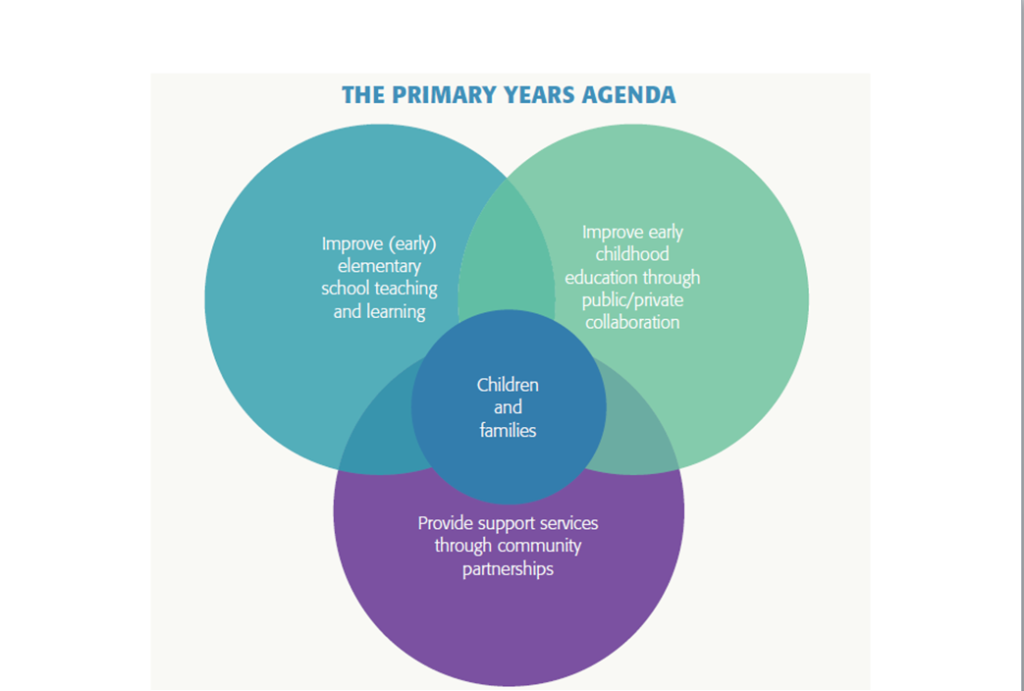Five Practical Lessons about Birth–3rd Partnerships: Feedback Requested
A chief benefit of blogs is the interactive dialogue they can support. With the Birth–3rd Learning Hub, I have an opportunity to test ideas with people who are deeply involved in doing Birth–3rd work. A few weeks ago I posted a number of “lessons” based on the work thus far, giving examples of each to illustrate the central…
Does Your Design Process Look Like This?
Does your partnership sometimes “go wide” before focusing in on concrete strategies? For a helpful toolkit on designing new strategies, initiatives, and/or programs, see Design Thinking for Educators by the renowned design firm IDEO. Thanks for Bob Ettinger of Cambridge for sharing this resource. To see a creative application of this process to early education, check out the…
Ambitious Vision: Principal Leadership in PreK–3rd Learning Communities
The National Association of Elementary School Principals has published an ambitious vision of the principal’s role in PreK–3rd reform. This report, Leading Pre-K-3 Learning Communities: Competencies for Effective Principal Practice, outlines six competencies that together form a comprehensive approach to leading early learning partnerships. This approach will require district support in addition to principal leadership. The full…
Putting Seattle’s Pre-K Ballot Initiatives in Context
While most of the country’s obsessive politics-watchers will be surveying a variety of hotly contested Senate, House, and gubernatorial races on November 4, the early education community will have an eye trained on Seattle, Washington. Voters there will have not one, but two early education programs on the ballot. See Connor Williams’ piece on New America…
What We’re Learning

In last week’s post I showed how the work of Massachusetts’ Birth—3rd partnerships is “spilling over” in unexpected and promising ways due to the creation of new social and institutional relationships. These spillovers illustrate how the new relationships that partnerships create can lead to new strategies and build capacity for ongoing improvement. These developments are…
New Article in Kappan Magazine

Kappan Magazine has just published an article I wrote , The Primary Years Agenda: Strategies to Guide District Action. I draw on examples from Massachusetts and other states to make the case for three Birth-3rd strategies. These strategies are as relevant to communities as they are to districts. They are intended to help set priorities…
Relationships, Capacity, and Innovation

Innovations often evolve out of a series of what may seem to be minor developments. As a consequence, instead of waiting for disruptive products and technologies, we need to create the conditions for individuals, groups, and organizations to adapt, innovate, and improve all the time. –Thomas Hatch, Innovation at the Core. Principals pick up the…
Quality of Words, Not Quantity, Is Crucial to Language Skills, Study Finds
From yesterday’s New York Times: It has been nearly 20 years since a landmark education study found that by age 3, children from low-income families have heard 30 million fewer words than more affluent children, putting them at an educational disadvantage before they even began school. The findings led to increased calls for publicly funded prekindergarten…
Massachusetts Full-Service Program Yields Results in Elementary Schools
By the start of middle school, The Afterschool Corp. estimates that children in poverty have received 6,000 fewer hours of learning outside of school—both enrichment and support—than their middle-income peers. While many programs target low-income students who are struggling academically or emotionally, it can be more difficult to find enrichment activities to build on the…
Kindergarten-Readiness Tests Gain Ground
This Education Week article discusses new kindergarten-readiness assessments, including advances and concerns. See comments by Kyle Snow and Libby Doggett in the excerpts below. All 3,500 kindergarten teachers in Maryland are using a new readiness assessment this year that rests on teachers’ observations of children’s work and play to build a detailed picture of what they…